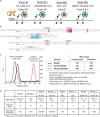Antibody elicited by HIV-1 immunogen vaccination in macaques displaces Env fusion peptide and destroys a neutralizing epitope
- PMID: 34697307
- PMCID: PMC8545924
- DOI: 10.1038/s41541-021-00387-4
Antibody elicited by HIV-1 immunogen vaccination in macaques displaces Env fusion peptide and destroys a neutralizing epitope
Abstract
HIV-1 vaccine design aims to develop an immunogen that elicits broadly neutralizing antibodies against a desired epitope, while eliminating responses to off-target regions of HIV-1 Env. We report characterization of Ab1245, an off-target antibody against the Env gp120-gp41 interface, from V3-glycan patch immunogen-primed and boosted macaques. A 3.7 Å cryo-EM structure of an Ab1245-Env complex reveals one Ab1245 Fab binding asymmetrically to Env trimer at the gp120-gp41 interface using its long CDRH3 to mimic regions of gp41. The mimicry includes positioning of a CDRH3 methionine into the gp41 tryptophan clasp, resulting in displacement of the fusion peptide and fusion peptide-proximal region. Despite fusion peptide displacement, Ab1245 is non-neutralizing even at high concentrations, raising the possibility that only two fusion peptides per trimer are required for viral-host membrane fusion. These structural analyses facilitate immunogen design to prevent elicitation of Ab1245-like antibodies that block neutralizing antibodies against the fusion peptide.
© 2021. The Author(s).
Conflict of interest statement
The authors declare no competing interests.
Figures




Similar articles
-
Cryo-EM structure of a CD4-bound open HIV-1 envelope trimer reveals structural rearrangements of the gp120 V1V2 loop.Proc Natl Acad Sci U S A. 2016 Nov 15;113(46):E7151-E7158. doi: 10.1073/pnas.1615939113. Epub 2016 Oct 31. Proc Natl Acad Sci U S A. 2016. PMID: 27799557 Free PMC article.
-
Immunogenicity of a Prefusion HIV-1 Envelope Trimer in Complex with a Quaternary-Structure-Specific Antibody.J Virol. 2015 Dec 30;90(6):2740-55. doi: 10.1128/JVI.02380-15. J Virol. 2015. PMID: 26719262 Free PMC article.
-
Asymmetric recognition of HIV-1 Envelope trimer by V1V2 loop-targeting antibodies.Elife. 2017 May 26;6:e27389. doi: 10.7554/eLife.27389. Elife. 2017. PMID: 28548638 Free PMC article.
-
Cross-Linking of a CD4-Mimetic Miniprotein with HIV-1 Env gp140 Alters Kinetics and Specificities of Antibody Responses against HIV-1 Env in Macaques.J Virol. 2017 Sep 12;91(19):e00401-17. doi: 10.1128/JVI.00401-17. Print 2017 Oct 1. J Virol. 2017. PMID: 28490585 Free PMC article.
-
Design, expression, and immunogenicity of a soluble HIV trimeric envelope fragment adopting a prefusion gp41 configuration.J Biol Chem. 2005 Jun 17;280(24):23138-46. doi: 10.1074/jbc.M414515200. Epub 2005 Apr 15. J Biol Chem. 2005. PMID: 15833740
Cited by
-
Intermediate conformations of CD4-bound HIV-1 Env heterotrimers.Nature. 2023 Nov;623(7989):1017-1025. doi: 10.1038/s41586-023-06639-8. Epub 2023 Nov 22. Nature. 2023. PMID: 37993719 Free PMC article.
-
Redox-neutral, metal-free tryptophan labeling of polypeptides in hexafluoroisopropanol (HFIP).RSC Chem Biol. 2024 Aug 26;5(10):963-9. doi: 10.1039/d4cb00142g. Online ahead of print. RSC Chem Biol. 2024. PMID: 39234575 Free PMC article.
References
Grants and funding
LinkOut - more resources
Full Text Sources

